Genre: Sports Publisher: Acclaim Developer: Domark Players: 1 – 2 Released: 1996
Disclaimer: Though this game is called Total Football, it doesn’t refer to the American pastime where everyone gets to stop every few yards to take a breather. No, this is a European exclusive. And we Europeans like our balls not stretched out and egg-shaped, but big, firm, and supple. As such, Total Football is a simulation of the popular team sport North Americans tend to call “soccer.”
Being born late in the Genesis life cycle and produced in and released exclusively for a European market (though allegedly there also was an Australian release), makes Total Football a rather obscure game. Those Americans who like soccer games on their Genesis should also be warned that the game isn’t optimized for the NTSC region. It isn’t region locked, but it runs at a much faster pace than the intended PAL speed, which is already pretty fast in itself. So to those wanting to try the game out on unmodded NTSC consoles, be warned: you’re in for an even more hectic affair than the game already is.
Like many other European-made console games during the ’90s, a version of this was also brought to Amiga home computers. What’s interesting though is that the team behind both versions was apparently very small. Judging by the credits, Total Football was an effort by two people, Richard Walker (programming and design) and Rob Hill (design and artwork). Interestingly enough, there aren’t many video game credits to both of their names. Walker was the slightly more prolific one of the duo and did a handful of conversions, but Total Football seems to be the only title in their portfolio of their own design. So it’s kind of remarkable that the two of them decided to develop yet another soccer game and publish them on two platforms that were nearing the end if their commercial life. Well, that’s not quite fair. It’s not just “yet another soccer game,” since they tried to take a rather unique spin on the genre, and to a degree, they succeeded in that attempt.
The name of the game, Total Football, alludes to a school of soccer theory developed in the 1960s and 1970s. Its inventor, if there’s any one man to single out, was Rinus Michels, the Dutch football coach who lead the team Ajax Amsterdam throughout its most successful years, winning the highest European team trophy, the European Champions’ Cup, three times in a row between 1971 and 1973. He also almost won the world championship training and managing the Netherlands during the 1974 World Cup, where they finished second after Germany. “Total football” refers to a fluid system within a teams’ structure: No player (other than the goalie) stays in a fixed role. Whenever a member of the team moves out of his position, another one immediately takes his place. So in such a system, every team member must be capable of taking over every part of the team at short notice, playing in a defending, attacking or in a midfield position whenever the need arises. Usually, this also centers around one or two driving players who drive the organizational structure. The result should be a well-oiled machine of a team that never leaves any significant openings, is able to outmaneuver any opposing strategy thanks to its fluid system and makes counterattacks very hard to pull off.
It appears that Walker and Hill deliberately named their game Total Football after this kind of strategy, since they chose an interesting gameplay mechanic that is very dependent on the position of a player on the pitch. In most soccer games of the era, you had one button for passing the ball (sometimes two when the game differentiated between high and low passes), and one button – usually the C button in Genesis games – for shooting the ball straight on (either aimlessly forward or ideally straight at the goal). In Total Football, however, what the C button does is entirely dependent on the current position of your player. While on the defense, it causes a wide clearing shot that’s relatively hard to get under control afterwards. On a wing position it results in a cross towards the center, which, when used wisely, can cause many a dangerous scoring situation. Strikers, naturally, will shoot at the goal, sometimes even lending a little curve to their shot that’s harder to block. This gameplay mechanic is certainly a nice idea and gives the game a more versatile and unique flavor that most other soccer games have. The position a player is in really feels different gameplay-wise that way. However, it is also a bit cumbersome, since that constant switching around of the controls makes the game less intuitive. Especially in the beginning, you will quite often curse when at one moment it causes you to shoot and the next to pass, and it’s not easy making these split-second decisions whether it’s better to press B or C at any given moment. It seems like such a mechanic would be more at home with the Amiga home computers, where most games usually have to share one button for all the controls.
The game also has a couple of other quirks that make it stand out from most other soccer games, for better and worse. Most obvious among those is the perspective. At first glance, Total Football uses an isometric perspective similar to EA’s FIFA Soccer line of game, albeit at a slightly lower angle. So the goals are located at the upper right and lower left end of the pitch, respectively. However, the controls do not quite reflect that setup. In games with isometric perspective like the aforementioned FIFA series or Head-On-Soccer, the default setup of the D-pad causes you to run in the exact same direction pressed: Up goes up, down goes down, and if you want to head directly from one goal to another, you press the according diagonal direction. Total Football, meanwhile, interprets these controls slightly differently. Pressing up doesn’t lead to the player moving directly upwards, but rather parallel to the direction of the pitch; pressing a diagonal direction makes you run at a slightly different diagonal angle than expected, roughly in the direction of a corner. This is very disorienting at first, though unlike the button control scheme, you get used to it after a while.
The game is also missing a couple of other, minor control elements you might be used to from other games in the genre. There’s no substituting players, and also no injuries, though there are fouls, penalties and even players being sent off after particularly unfair attacks. Also, even though there are no injuries, particularly hard tackles may cause a player to get hurt in some manner anyways, causing him to hobble, move at a much slower pace and being less capable of controlling the ball for a while. This opens the game up for more strategic strategy when fouling. Incapacitating a key striker on the opposing team for a few precious seconds may be well worth risking that yellow card.
More annoyingly, the game doesn’t allow you to manually switch what player you want to control while on the defense. In fact, it doesn’t switch out the player at all but rather leaves you in control of the last one in your team who had touched the ball. This feels like an almost negligent omission. Quite often you feel yourself being forced trailing behind an opponent while you could just as well attack him from the side or take him on in a duel, if you could just switch to that other teammate of yours. You can only order your teammate to attempt a tackle, which isn’t always recommendable. Also, wresting the ball away from another player, should you ever get the chance, feels rather stiff, and sometimes you might end up accidentally tackling your opponent or kicking away the ball blindly because you were unable to determine whether your own player actually had control of it after a duel or not.
One a more positive note, the ball physics are pretty good. The ball doesn’t just go in straight lines but occasionally has a little swerve to it, and its bounce feels rather natural. The graphics are also pretty good for the most part, even though the animations feel a little stiff sometimes, especially after scoring a goal, when three or more players suddenly run through the same animation cycle simultaneously, which makes them come off like some sort of creepy drone collective.
The rest of the game is rather standard. One half time can last three, five, 10, 20 or the full 45 minutes each, matches may be decided by shootout and/or overtime, and referee strictness can be set in the options menu (as can the weather conditions). Game mode includes exhibition, 16-team-league, 32-team knockout tournament or a world cup-like mode consisting of both group and knockout stages. As a more simulation-oriented representative of the video game soccer genre, Total Football makes a good and rather realistic use of the offsides rule as well. Strangely, even with all its strategic elements, the game seems rather loose when it comes to team management: At the beginning of a half time you can determine your team’s formation – that’s it.
Total Football tries to be unlike other soccer titles in many regards, and at times, it succeeds. It definitely feels different from the standard formula most games in that genre followed during the era. Making certain shots dependent on what position you’re in and the way it handles tackles make it feel more strategic than most of its contemporaries, and both graphics and physics-wise it does a pretty good job. However, at times it tries too hard to be different, to the detriment of the gameplay. It’s not easy to get used to its quirky controls, and it feels a bit too stiff at times. Being released rather late in the console’s life cycle didn’t help much either. As such, the game didn’t leave its mark on the genre, although it does make for an interesting footnote.
Score: 6 out of 10

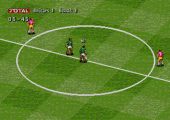
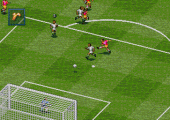
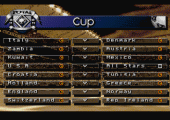
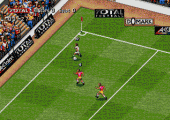
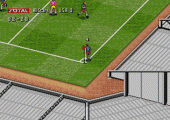
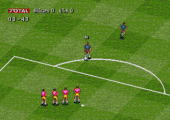
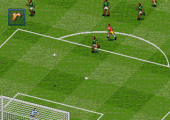
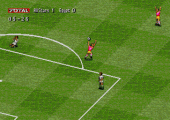

Recent Comments